Trending
New Manhattan condos see rise in foreclosures
A look at the buildings with the most lis pendens in the last year
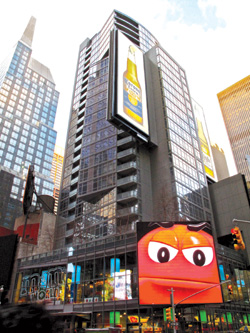
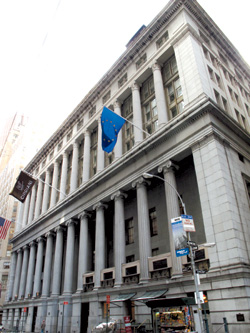
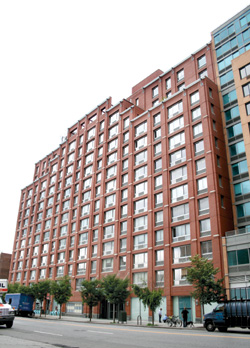
From left: 1600 Broadway, Cipriani Club Residences and 555 West 23rd Street
One in every 13 homes is in some stage of foreclosure. Half are either listed for rent or sale, some at 30 percent less than what the previous owner paid only a few years earlier.
This predicament isn’t playing out in some outer-borough neighborhood. It’s happening in Manhattan, behind the Grecian stone columns and hulking bronze doors of the Financial District’s Cipriani Club Residences, the ultra-luxurious condo conversion at 55 Wall Street.
The building, a joint venture between famed restaurateur Giuseppe Cipriani and the Witkoff Group, is one of dozens in Manhattan where multiple owners have fallen behind on their mortgages. At the Cipriani, eight of the 106 units in the building are in distress, and several of those are owned by the same investor, as is the case in other buildings.
Foreclosure filings for Manhattan condos more than doubled last year to 725, compared to 2008, when there were only 322 filings, according to real estate data aggregator PropertyShark.
It should be noted that only a few dozen of the total Manhattan filings in 2009 were auctions, the last stage in the state’s notoriously long foreclosure process. Most were “lis pendens,” the pre-foreclosure notice sent after an owner falls into arrears on common charges or is at least three months late paying the mortgage.
Some homeowners intentionally fall into pre-foreclosure to encourage the bank to lower their interest rate, which can shave thousands of dollars off their monthly payments. Several owners contacted for this story said they successfully used this tactic and are no longer technically “in foreclosure.” But there is no public filing indicating a lis pendens has been satisfied, so this trend, however widespread, is difficult to track.
This month, The Real Deal researched a top-10 list of buildings in Manhattan (see below or click here for the accompanying chart) with the most units that received a pre-foreclosure filing at any point between March 2009 and the middle of last month (there were no auction filings in these buildings). The numbers were based on an analysis of data provided by PropertyShark.
All but two of those buildings (there are actually 11 on the list because of ties) are condos completed at the peak of the market, and none are in discount neighborhoods.
Five of the buildings on the list had distress rates higher than Jamaica, Queens, considered the epicenter of the city’s foreclosure crisis, where one out of every 17 homes has received a foreclosure filing over the past year.
Other buildings on the top 10 list are so large that the overall percentage of distressed units is relatively low. Extell’s Gary Barnett, developer of the Orion Condominium, noted his building has 551 units, so seven units with a pre-foreclosure filing only “represents slightly more than 1 percent.” He added that the distressed owners probably bought with little equity. (That point is true in all but one case at the Orion, according to publicly filed mortgage documents.)
The top building on the list — the Atelier, overlooking the West Side Highway — has 21 apartments with pre-foreclosure filings, which represents 4 percent of its 478 apartments. The Moinian Group, which completed the tower in 2007, did not return calls for comment.
“These new development condominiums have seen one of the largest price decreases in the downturn,” said PropertyShark’s CEO, Bill Staniford. “And we know that when people go underwater — which is probably the case with the vast majority of the properties that are in distress or in foreclosure, they’re underwater because they’ve lost their value — it also puts downward pricing pressure on the other units that are for sale.”
Similar to low-rise neighborhoods with a high concentration of distress, industry experts said everyone who owns a unit in a building with multiple apartments in distress is vulnerable, particularly if they’re trying to sell.
Plus, condos have one major twist — common charges, which often go unpaid when an owner hits rocky financial waters. Eventually, if a large enough percentage of owners don’t pay their common charges, everyone else has to pay more, or the building must cut maintenance and service costs, said William West, CEO of property management firm Charles H. Greenthal Management Corp.
The board governing one condo on the list increased monthly charges 15 percent because at least one investor, who owns a dozen units in the building, is in arrears, said a board member who requested anonymity.
Investor-driven foreclosures
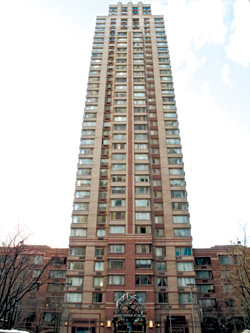
Worldwide Plaza
Tellingly, all but two of the buildings on the list, Worldwide Plaza and 130 Barrow Street, are new.
Investors own many of the distressed apartments in these buildings, but plans to rent and then flip them for huge profits were spoiled by the financial collapse in 2008 that was followed by overall price drops of roughly 25 percent.
Many of these apartments have instead become money drains, brokers said.
The Real Deal estimated the monthly carrying costs on a dozen apartments with lis pendens filed against them, based on publicly filed mortgage documents and the taxes and common charges disclosed in the buildings’ real estate ads. In every case, the total carrying costs significantly exceeded the rental listing price for a comparable apartment in each building.
Even when listed at big discounts, the numbers on these apartments don’t always work for new buyers, at least without a sizable down payment. (During the boom, rental income didn’t necessarily cover monthly carrying costs, but investors justified the short-term losses because they expected their properties to rapidly appreciate in value. That hasn’t happened, and the spread between rental income and monthly carrying costs has widened in the recession.)
One of the eight apartments that had a pre-foreclosure filing against it at the Cipriani Club — a barely used, stylishly furnished studio owned by a South Korean investor — is listed for $525,000 as a short sale, 35 percent less than the owner paid in 2006. However, it’s been on the market for eight months (slightly longer that the 203-day average for condos that Miller Samuel calculated for 2009).
Aside from the onerous short-sale process, the apartment’s broker, Frederico Ziotto of Columbus NY Real Estate, said he’s been having trouble selling the studio because a new investor putting 20 percent down would still take a monthly loss renting the place, despite its clearance price and the historically low mortgage interest rates available today.
He said the problem is the common charge, $1,095 per month for the 601-square-foot studio. “The common charge in the Cipriani was created for a very wealthy clientele and in this market, nobody wants to pay a high common charge,” Ziotto said.
At the time the conversion was finished in the cash-flush days of 2006, it was said that Cipriani’s celebrity status alone added 20 percent to prices there. Each apartment came pre-outfitted with designer furniture and flat-screen televisions in every bathroom. Residents are treated to hotel-like amenities like butler and housekeeping services, and two years’ free access to the gym, library, billiards room and barbershop — all at what now seems like a very steep price.
The current owner’s monthly carrying costs for her two mortgages, taxes and
common charges total around $5,750 — for a studio that Ziotto said only rents for $3,000 per month. He said the last renter was planning to buy the apartment at the short-sale price, but instead signed a contract for one of the larger, remaining sponsor units.
Ziotto said prices at the Cipriani only work for people who plan on living there for several years until the market picks up, investors who have a large down payment, or perhaps international travel agents with plans to rake in more cash renting the apartment like a hotel.
“The [mortgage] rates for investors are 2 to 3 percent more than regular financing. So a buyer that is buying to rent it would get a rate of 6.5 percent or more. It is impossible [for the rent-buy calculation to be favorable] then,” said Ziotto.
Another broker who has been active in the building since sales began there more than four years ago commented, “We found them difficult to sell because the minute everybody closed, everybody wanted a renter, so you had all these rentals at the same time.”
Cipriani’s developer, the Witkoff Group, declined to comment for this article.
Pari Passu broker Susie Park was marketing one of the 19 apartments with a lis pendens filed against it within the last year at 200 Chambers Street, a 258-unit tower in Tribeca finished in 2007. Like the Cipriani Club investor, the owner of this one-bedroom financed more than 80 percent of the purchase through two mortgages, records show.
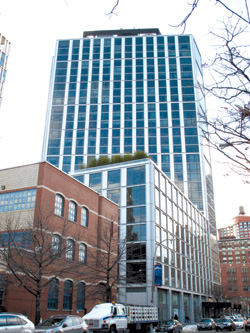
200 Chambers Street
Park said the owner doesn’t make enough in rental income to cover the monthly bills.
“This owner, along with several others in the building that are in foreclosure or in default with the bank, is mostly trying to work out some sort of loan modification,” she said. “These are million-dollar apartments; I highly doubt they would just let them get foreclosed on.”
The monthly payments for another two-bedroom apartment at 200 Chambers total around $12,000, according to The Real Deal‘s calculations (the owner financed 90 percent of the $1.8 million purchase through two mortgages). That apartment was listed for rent in August for $6,500, according to the listings aggregator StreetEasy.
At the Downtown Club on 20 West Street, also by the Moinian Group, 12 of the tower’s 283 apartments are in pre-foreclosure.
City Connections Realty broker Edward Longley, who is marketing one of those apartments, said his investor client was losing up to $1,500 a month renting the apartment.
By Longley’s account, the owner never actually made enough to cover the monthly payments. The one-bedroom was purchased for $660,000 in 2007, and it has been sporadically listed for sale for $499,000 for more than a year. Longley is awaiting bank approval on the short-sale price.
Short sale, long process
Short sales — when an owner sells a property for less than the mortgage is worth — are a long process.
“Every bank in the country has millions of foreclosures,” said Longley, who estimated that it might take nine months for his short sale to be approved. “It’s not that the banks don’t care about it, there’s just not enough manpower.”
Second mortgages or lines of credit complicate matters, because that subordinate creditor is second in line to be paid, and will often take more aggressive action against a debtor.
“The trouble right now is that the first mortgagee, meaning Bank No. 1, is willing to agree to the short sale. But Bank No. 2, for whom technically there’s no money, is not agreeing to cooperate, to such an extreme that Bank No. 2 is asking the seller to sign a promissory note indicating that the seller will be personally liable after the sale for the balance left,” said Lior Aldad, the founder of the law firm Aldad & Associates, who is representing several Manhattan condo owners in foreclosure.
Unlike co-op boards, which are first in line to be paid when a distressed apartment is sold, West of Greenthal Management said condo boards are the last.
Therefore, the boards will often file an official lien on the property, and only waive their right to refuse a new buyer if the bank agrees to pay them upon closing the sale.
Sometimes the board even moves to foreclose on the property itself to force payment, which is the case with some of the apartments on the list.
Multiple liens affect other owners trying to sell in that building because they make banks generally leery of lending there, said Jonathan Miller, president of appraisal firm Miller Samuel.
“Lenders are already challenged with lending to begin with,” he said. “Common charges in arrears would be something they do look at.”
And if too many owners are in arrears on their common charges, banks sometimes deny refinancing applications from others in the building who are making their payments on time.
One owner of a new condo in the East Village said Bank of America denied her refinancing application because the board’s reserve account is depleted, and 17 percent of the owners are delinquent on their common charges, exceeding the bank’s 15 percent threshold. Bank of America did not return requests for comment.
Playing chicken with foreclosure
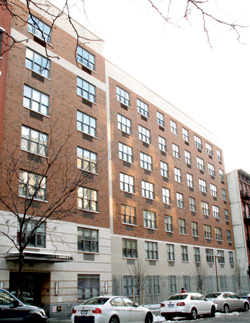
be@Clinton West
Sometimes an owner will not pay the mortgage for several months as a strategy to encourage the bank to modify the terms of their loan, by “proving” the loan can’t be paid under the original terms, but could be under better terms.
That’s what Park said she did to lower the interest rate for a condo she owns at the Downtown Club, which had a lis pendens filed against it last July.
And the foreign investor at the Cipriani Club who owns several units in pre-foreclosure claimed that he is intentionally not paying the mortgage so the bank will modify his loan, said a source within the building.
An owner of another apartment at the Downtown Club with a lis pendens filed against it, said he “took a break” from paying the bank and was able to negotiate his monthly mortgage payment down from $3,300 per month to $2,000 per month.
“I own a construction company and business went down. I own several properties,” the owner said last month during an interview at his apartment, explaining that for a time he couldn’t make payments on all of his properties at once, but knew the bank would cut him a deal. Ultimately, he said the bank agreed to move his unpaid balance to the principal and reduce his interest rate from 6.2 percent to 3 percent.
“It’s a shame that a lot of people let their units get foreclosed on without knowing they can do something,” the owner said.
Others are not so lucky, like a creative professional who said he’d probably lose his apartment at be@Clinton West, where seven of 147 apartments had pre-foreclosure filings.
Records show he purchased his studio apartment in 2007 for $507,000 — 25 percent more than the previous owner paid three months earlier — with almost zero equity by taking out two mortgages.
“My one loan is about 8 percent interest only and the other is 13 percent interest only,” said the owner, who agreed to discuss his predicament if he could remain anonymous. “I was told by an associate at [lender] SunTrust at the time that this is probably the only way I could get a mortgage and that I could refinance a little down the road with equity.”
“I knew going in that it was a ridiculously high interest,” he said. “But I thought I would live tight for a year or so and then refinance based on the equity, which at the time seemed like a great plan. I’m not saying I was coerced, but I was excited to buy my first place and I wanted to believe I could make it work.”
Unfortunately, his business declined along with the economy, leaving him with no money to put toward equity. He said the bank has refused to modify the terms of his loan.
Mario Procida of SDS Procida, the building’s developer, expressed remorse for the struggling owners in his building but declined to comment further on the matter.
Breaking down the buildings with the most foreclosure filings
Foreclosure filings for Manhattan condos are on the rise and new condo buildings have been particularly hard-hit. The following is a top-10 list of the buildings in Manhattan with the most individual units that had foreclosure filings against them sometime between March 2009 and mid-February 2010, according to PropertyShark data compiled by The Real Deal. The filings were all lis pendens or “pre-foreclosures,” the earliest stage of the process. While those apartments only represent a tiny percentage of larger buildings like the Orion Condominium, the percentage becomes more significant in smaller buildings like the Cipriani Club Residences, where one in every 13 apartments had a filing. Since there’s no public filing indicating that an owner satisfied the outstanding balance with the bank, some of these foreclosures may have been worked out.
1. Atelier at 635 West 42nd Street in Clinton by the Moinian Group: 21 units, or 4 percent of 478 units, had foreclosure filings. The building was finished in 2007.
2. 200 Chambers Street in Tribeca by Jack Resnick & Sons: 19 units, or 7 percent of 258 units, had foreclosure filings. The building was finished in 2007.
3. Downtown Club at 20 West Street in the Financial District, by the Moinian Group: 12 units, or 4 percent of 283 units, had foreclosure filings. The building was converted into a condominium in 2005.
4. Worldwide Plaza at 350 West 50th Street in Clinton, built by William Zeckendorf Jr.: 11 units, or 2 percent of 455 units, had foreclosure filings. The building was finished in 1989.
5. 1600 Broadway on the Square in Times Square, by Sherwood Equities: 10 units, or 7 percent of 139 units, had foreclosure filings. The building was finished in 2006.
6. (tie) Millennium Tower Residences at 30 West Street in Battery Park City, by Millennium Partners: 9 units, or 4 percent of 236 units, had foreclosure filings. The building was finished in 2006.
6. (tie) 130 Barrow Street in Greenwich Village, by Sherwood Equities: 9 units, or 9 percent of 95 units, had foreclosure filings. The building was converted into a condominium in 1982.
8. Cipriani Club Residences at 55 Wall Street in the Financial District, by Cipriani & Witkoff: 8 units, or 8 percent of 106 units, had foreclosure filings. The building was converted into a condominium in 2006.
9. (tie) 555 West 23rd Street in Chelsea, by Douglaston Development: 7 units, or 2 percent of 337 units, had foreclosure filings. The building was finished in 2005.
9. (tie) Orion Condominium at 350 West 42nd Street in Chelsea, by Extell Development: 7 units, or 1 percent of 551 units, had foreclosure filings. The building was finished in 2006.
9. (tie) be@Clinton West at 516 West 47th Street in Clinton, by SDS Procida: 7 units, or 5 percent of 147 units, had foreclosure filings. The building was finished in 2006.
Sources: The lists of auction and lis pendens filings in Manhattan were provided by PropertyShark. The Moinian Group, Sherwood Equities, Millennium Partners and Douglaston Development did not respond to requests for comment by press time. SDS Procida, Jack Resnick & Sons and Cipriani & Witkoff declined to comment.




